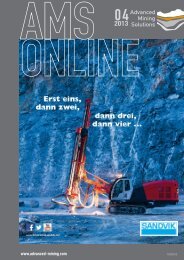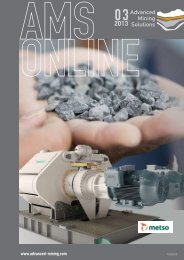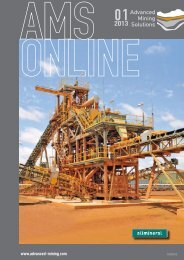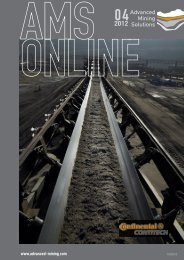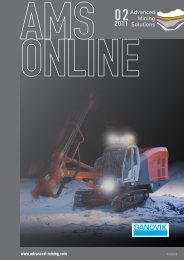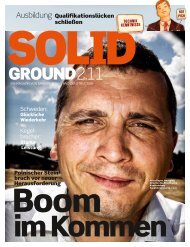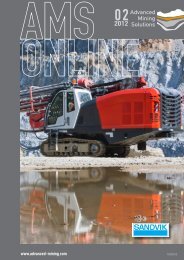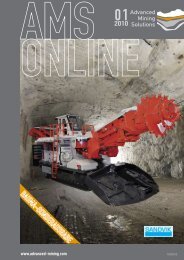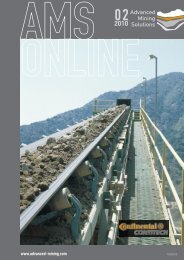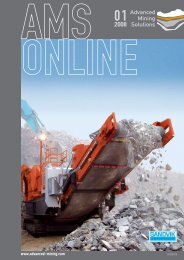A new face drilling rig for narrow tunnels and ... - Advanced Mining
A new face drilling rig for narrow tunnels and ... - Advanced Mining
A new face drilling rig for narrow tunnels and ... - Advanced Mining
You also want an ePaper? Increase the reach of your titles
YUMPU automatically turns print PDFs into web optimized ePapers that Google loves.
measurement of the structure-borne<br />
noise through vibration pick-ups on<br />
the supporting frame of the lifting<br />
gear drive units <strong>and</strong> on the central<br />
column, made in parallel with it,<br />
have shown the dominance of the<br />
meshing frequency of the input gear<br />
taken at approx. 500 Hz within the<br />
range of the structure-borne sound<br />
<strong>for</strong>mation. The drive motors of the<br />
lifting gear proved to be the main<br />
source of airborne sound <strong>for</strong>mation. The frequencies of the<br />
airborne sound emitted by the motors are 2500 Hz or twice<br />
the pulse rate of the frequency converters. The same goes<br />
<strong>for</strong> the slewing drive gears. It is only the meshing frequency<br />
of the planetary gearboxes which differs from that one of<br />
the bevel wheel gearboxes belonging to the lifting gear.<br />
The aim of the structure-borne sound measurements<br />
is to establish the transmission paths of the sound, <strong>and</strong> to<br />
correlate the respective shares with the airborne sound<br />
measurements, in order to be able to quantify the shares<br />
the individual sources of sound have in the overall noise.<br />
The structure-borne sound of the lifting gear drive units<br />
is lead into the crane’s structural steelwork through the<br />
floor of the machine house, <strong>and</strong> its radiation takes place<br />
over the large-sur<strong>face</strong> steel structure of the crane’s upper<br />
section, including the boom, <strong>and</strong> the portal that is arranged<br />
underneath the machine house. The central column acts as<br />
baffle <strong>for</strong> the structure-borne sound stimulus, transmitted<br />
through the slewing drive units <strong>and</strong> the ball-race slewing<br />
connection into the central column.<br />
Actions intended to reduce noise should begin at the<br />
noise source, if possible, be<strong>for</strong>e taking secondary ones.<br />
That is the reason why the gearboxes have been equipped<br />
with a noise-optimized tooth. But this action could only<br />
contribute to a slight reduction of the sound power of<br />
approx. 1.5 dB. So, secondary actions near the noise source<br />
needed to be taken. To this end, the drive units belonging<br />
Issue 04 | 2010<br />
TRANSFER OF TECHNOLOGY<br />
Fig. 10:<br />
Slewing crane – General<br />
arrangement drawing<br />
to the lifting gear have been fixed on flexible supports to<br />
the steel structure. The design of such flexible supports<br />
requires particular care to obtain the best possible<br />
insulation. An execution while basing on the st<strong>and</strong>ard VDI<br />
2062 also requires the keeping of the maximum load factor<br />
of Elastomers, given by the manufacturer. The airborne<br />
sound emitted by the units get to the outside through the<br />
ventilation apertures provided <strong>for</strong> in the machine house,<br />
the opening to enable the rope passage <strong>and</strong> the hollow<br />
central column.<br />
All openings, including that one allowing passage of<br />
rope, have been equipped with sound absorbers. The<br />
ventilators have been designed in a noise-optimized way,<br />
<strong>and</strong> the plane on which the central column goes outdoors<br />
got completely closed by means of sound insulation<br />
elements having a sound insulation factor of R=30dB. When<br />
designing sound insulation elements, care must be taken<br />
that the sound insulation factor given by the manufacturer<br />
will not be reached on constructions, as it relates to a<br />
single element while taking into account ideal conditions.<br />
On constructions consisting of these elements the sound<br />
insulation factor to be reached gets reduced to approx. 8<br />
to 15 dB, dependent on the execution <strong>and</strong> the complexity<br />
of the construction.<br />
www.advanced-mining.com<br />
80



